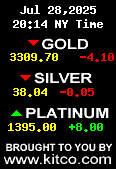

| Item | Properties | Weight | Dimension | Thickness | Date |
| 1971 RM1 Malaysia Coin | n/a | 17.0 g | 24.55 mm dia | Approx. 3.5 mm | April 2010 |
My blog about my gold & silver collectios..coins, gold&silver coins, gold&silver bars...anything about gold&silver...& coins...


| Item | Properties | Weight | Dimension | Thickness | Date |
| 1971 RM1 Malaysia Coin | n/a | 17.0 g | 24.55 mm dia | Approx. 3.5 mm | April 2010 |



| Item | Properties | Weight | Dimension | Thickness | Date |
| 2001 Australian Kookaburra 1 oz Silver Coin | 99.9% fine Silver | 31.11 g | 40.6 mm dia. | 4.0 mm | 27 April 2010 |
The seven best ways to ruin your coins are things that many beginning collectors do without even thinking about them. I've even seen expert coin dealers spitting on their coins! If you care about protecting the investment you're making in your coin collection, take the time to learn how to properly handle, clean, store, and protect your rare coins.
1. Touch Your Coins
Just touching your coins with your bare fingers is enough to cause damage to them, especially if you collect higher grade coins. And you will definitely damage them if your fingers come in contact with mint-state and proof coins. Your fingers contain oils and miniscule pieces of grit that will adhere to the coins and cause them to discolor or suffer microscopic scratching. When you handle your coins, wear cotton or latex gloves, and handle only the edges.
2. Clean Your Coins
With the exception of freshly dug-up detector finds, cleaning or polishing your coins will do more harm than good. Once metal has been exposed to the air, it is natural for it to oxidize, or tone. If you strip the coin of this toning, not only will you lose any remaining mint luster, the coin will appear harsh and unappealing, and suffer microscopic abrasions that lower its grade. Plus, toned coins are worth more than stripped coins. If you really must clean them, clean coins safely.
3. Spit on Your Coins
Talking about your coins can do just as much damage as touching them or cleaning them, if you do so with the coins exposed while you chatter away. Little bits of saliva escape from your mouth when you talk, and these can cause spotting and discolorations that are difficult to remove. Many uncirculated and mint-state coins have been ruined this way. Say whatever you want about your coin collection, just make sure your coins are safe when you say it!
4. Break Their Holders
You are certain to greatly decrease the value of your mint set and proof set coins by removing them from the mint-issued holders they come in. The holders, along with the box and literature (if any) are part of the "set" and should be kept intact and pristine. Similarly, coins that have been slabbed are worth a premium in their protective cases. Never remove coins from these types of permanent holders.
5. Expose Them to Acid
Storing your coins in envelopes, wrapped in paper, with your notations beside the coins, or in cardboard boxes is a good way to damage them unless you are careful to use acid-free paper materials. Over time, the paper material breaks down, releasing acidic chemicals around your coins. This causes spotting, discoloration, and can promote oxidation (toning) of your bright, mint surfaces. Be sure to buy only acid-free paper and cardboard supplies for your coin collection.
6. Coat Your Coins in Green Slime
Another good way to cause spotting and degraded surfaces is to store your coins in PVC-based plastic flips, holders, and boxes. Similar to the way the acid in paper can harm your coins, the chemical by-product of certain plastics can damage your coins over time. If you store coins in those handy food-grade plastic containers, or in soft, pliable coin flips, your coins will eventually develop a slimy green coating on their surfaces which will damage them permanently.
7. Expose Them to the Elements
If you store your coins in the attic or basement, you are probably exposing them to extremes of temperature and humidity that will promote their oxidation. In addition, these conditions will more quickly break down the storage materials (such as flips, paper and cardboard, plastic containers, etc.) your coins are organized in. To protect your collection the best, store it in a dark, dry, temperature-controlled environment (such as a safe deposit box or specialized coin cabinet.)



| Item | Properties | Weight | Dimension | Thickness | Date |
| 2008 Australian Kookaburra 1 oz Silver Coin | 99.9% fine Silver | 31.11 g | 40.6 mm dia. | 4.0 mm | 08 April 2010 |


| Item | Properties | Weight | Dimension | Thickness | Date |
| 2007 Australian Kookaburra 1 oz Silver Coin | 99.9% fine Silver | 31.11 g | 40.6 mm dia. | 4.0 mm | 08 April 2010 |


| Item | Properties | Weight | Dimension | Thickness | Date |
| 1 Dirham IMN | 99.9% fine Silver | 2.975 g | 25.0 mm dia. | 1.0 mm | 01 April 2010 |




| Item | Properties | Weight | Dimension | Thickness | Date |
| 2009 Australian Koala 24k Gold Gilded 1 oz Silver Coin with NGC | 99.9% fine Silver | 31.11 g | 40.6 mm dia. | 4.0 mm | 01 April 2010 |
My site is worth$3,492.16Your website value?

